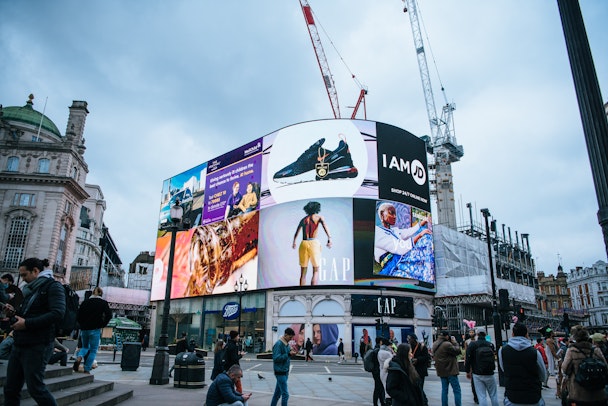How ‘Freedom Day’ has impacted UK out-of-home ad sales – and can it last?
Out-of-home advertisers were expecting a swell of activity (in England at least) on the subdued launch of so-called ‘Freedom Day’ – Monday 19 July – which walked back some of the Covid-19 restrictions the public has endured over the last year. For advertisers, theoretically, this meant greater footfall and some clients returning to spend. The Drum looks at how brands changed gear.

What will consumer behavior will look like after ‘Freedom Day’?
Transport for London (TfL) recently best summed up the out-of-home (OOH) sector’s excitement to see those footfall levels return after a lax year of reduced travel where inventory upgrades suddenly took precedence. It isn’t alone in anticipating a return to fortune – but will the sector return to pre-lockdown levels anytime soon? No [per IPA Bellwether], but here’s what industry execs say they are seeing.
Positive return
Luke Willbourn, chief client officer at Talon Outdoor, says he’s seeing a “really positive return to market from brands across the summer” due to two-thirds of adults now being fully vaccinated and them having confidence for a return to the entertainment, retail and travel sectors – which in turn will inspire more ad spend.
The outdoor media mix is changing, however. Willbourn says digital OOH revenue is at around 60% at Talon and is growing, but adds: “Traditional sites remain crucial as we find audiences still active locally.”
The issue with these static sites is that lead times are three to four months, so those using them really have to plan accordingly. And it has been a difficult time to do that.
Driving the most recent surge in spend in what was an understandably struggling medium, he says FMCG, drinks, car, media, tech and now travel brands lead the way. And coming ahead, the return of hospitality will have an impact.
“We are also now very well-placed to deliver technology and data advances for integrated media targeting alongside online advertising as brands seek to reconnect with their audience. We are generating outcome-led campaigns and creativity, and truly reaching audiences as they re-emerge from lockdown.”
Budget shift?
Jonny Whitehead, board director at Skyrise Intelligence, says he expects to see OOH budgets increasing in the next six months.
He says: “The first few months will be interesting, as some businesses move to a hybrid model of working from home and from the office, but already we are seeing an increase in commuter travel, and with audiences increasingly on the go, brands will need to be incorporating digital OOH into their marketing mix.”
Buyers have been using anonymized mobile network data just to track the sheer volume of footfall hitting these out-of-home sites so advertisers can “identify the optimal times and places to reach an audience based on up-to-the-minute travel patterns, and measure the effectiveness of their campaigns like never before”.
And, as Whitehead claims, this all works without “the use of any first- or third-party IDs”, which will increase its appeal to some businesses scratching their heads over the state of online privacy and advertising.
Predicting behavior
Amy Jackson, business director at digital advertising agency Incubeta, is tasked with working out what consumer behavior will look like after Freedom Day. After all, there are concerns about the fact the nation is ‘opening up’ too soon and there’s frivolous debates on the merits of mask-wearing – something many businesses have had to take a stance on.
“It’s clear that consumer confidence has been on the rise for a sustained period now, and while caution to go back into stores is a concern, retailers are beginning to produce strong brick and mortar figures.”
Jackson is cautious, aware that Freedom Day may be no such thing and that yet another lockdown could bite, despite rising vaccination levels.
“We can’t underestimate how quickly plans can change, and how quickly we could go back into a lockdown. The high street is reliant on people going back to the office, but Freedom Day has a dark cloud over it for many brands, as ultimately the transition back to high streets will be a slow one.” She urges for an omnichannel strategy that works even if Freedom Day fails.
Wider effects
The question is, what happens to all these behaviors we’ve built up in lockdowns? Mike Campbell, director of adtech for agencies and brands at Xandr, believes programmatic growth will decelerate: “The immediate necessity for consumers to shift online will have disappeared, but higher rates of digital adoption will continue.”
He believes that those who have now ‘finished Netflix’ “will be expecting TV on demand on any device going forward”, which opens up numerous options in the CTV space.
Meanwhile, people themselves have changed and moved. “Those that moved out of cities and bought houses in the suburbs will not be rushing back to studio flats – so those targeting their advertising at large millennial segments may find their audience is less interested as they now behave more like gen X audiences.”
This, coupled with the remote working boom, means that “OOH will not recover overnight”. Hence why it has focused on real-time insights and smarter campaigns targeting those who do remain in urban areas.

